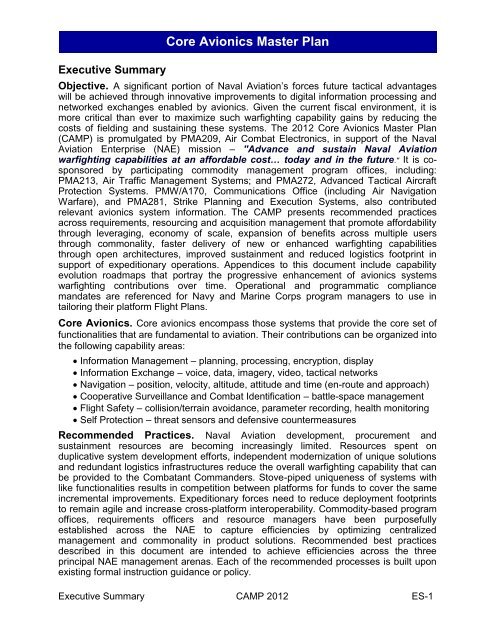PMA209 2012 Core Avionics Master Plan - NAVAIR - U.S. Navy
PMA209 2012 Core Avionics Master Plan - NAVAIR - U.S. Navy
PMA209 2012 Core Avionics Master Plan - NAVAIR - U.S. Navy
Create successful ePaper yourself
Turn your PDF publications into a flip-book with our unique Google optimized e-Paper software.
<strong>Core</strong> <strong>Avionics</strong> <strong>Master</strong> <strong>Plan</strong>Executive SummaryObjective. A significant portion of Naval Aviation’s forces future tactical advantageswill be achieved through innovative improvements to digital information processing andnetworked exchanges enabled by avionics. Given the current fiscal environment, it ismore critical than ever to maximize such warfighting capability gains by reducing thecosts of fielding and sustaining these systems. The <strong>2012</strong> <strong>Core</strong> <strong>Avionics</strong> <strong>Master</strong> <strong>Plan</strong>(CAMP) is promulgated by <strong>PMA209</strong>, Air Combat Electronics, in support of the NavalAviation Enterprise (NAE) mission – "Advance and sustain Naval Aviationwarfighting capabilities at an affordable cost… today and in the future." It is cosponsoredby participating commodity management program offices, including:PMA213, Air Traffic Management Systems; and PMA272, Advanced Tactical AircraftProtection Systems. PMW/A170, Communications Office (including Air NavigationWarfare), and PMA281, Strike <strong>Plan</strong>ning and Execution Systems, also contributedrelevant avionics system information. The CAMP presents recommended practicesacross requirements, resourcing and acquisition management that promote affordabilitythrough leveraging, economy of scale, expansion of benefits across multiple usersthrough commonality, faster delivery of new or enhanced warfighting capabilitiesthrough open architectures, improved sustainment and reduced logistics footprint insupport of expeditionary operations. Appendices to this document include capabilityevolution roadmaps that portray the progressive enhancement of avionics systemswarfighting contributions over time. Operational and programmatic compliancemandates are referenced for <strong>Navy</strong> and Marine Corps program managers to use intailoring their platform Flight <strong>Plan</strong>s.<strong>Core</strong> <strong>Avionics</strong>. <strong>Core</strong> avionics encompass those systems that provide the core set offunctionalities that are fundamental to aviation. Their contributions can be organized intothe following capability areas: Information Management – planning, processing, encryption, display Information Exchange – voice, data, imagery, video, tactical networks Navigation – position, velocity, altitude, attitude and time (en-route and approach) Cooperative Surveillance and Combat Identification – battle-space management Flight Safety – collision/terrain avoidance, parameter recording, health monitoring Self Protection – threat sensors and defensive countermeasuresRecommended Practices. Naval Aviation development, procurement andsustainment resources are becoming increasingly limited. Resources spent onduplicative system development efforts, independent modernization of unique solutionsand redundant logistics infrastructures reduce the overall warfighting capability that canbe provided to the Combatant Commanders. Stove-piped uniqueness of systems withlike functionalities results in competition between platforms for funds to cover the sameincremental improvements. Expeditionary forces need to reduce deployment footprintsto remain agile and increase cross-platform interoperability. Commodity-based programoffices, requirements officers and resource managers have been purposefullyestablished across the NAE to capture efficiencies by optimizing centralizedmanagement and commonality in product solutions. Recommended best practicesdescribed in this document are intended to achieve efficiencies across the threeprincipal NAE management arenas. Each of the recommended processes is built uponexisting formal instruction guidance or policy.Executive Summary CAMP <strong>2012</strong> ES-1

















